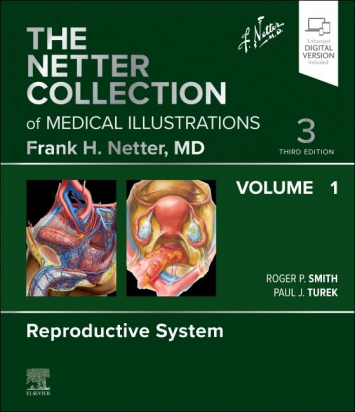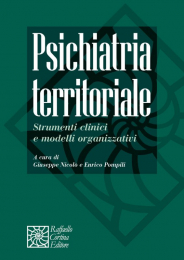Non ci sono recensioni
DA SCONTARE
| Description: Offering a concise, highly visual approach to the basic science and clinical pathology of the reproductive system, this updated volume in The Netter Collection of Medical Illustrations (the CIBA "Green Books") contains unparalleled didactic illustrations reflecting the latest medical knowledge. Revised by Drs. Roger P. Smith and Paul J. Turek, Reproductive System, Volume 1 integrates core concepts of anatomy, embryology, physiology, and genetics with common clinical correlates across health, medical, and surgical disciplines. Classic Netter art, updated and new illustrations, and modern imaging continue to bring medical concepts to life and make this timeless work an essential resource for students, clinicians, and educators. |
| Features: |
|
| New To This Edition: |
|
Feature: MODERN IMAGING Benefit: Netter’s classic anatomical illustrations (normal and abnormal) in multiple sections and views side-by-side the newest imaging technology commonly used throughout health professions.
Feature: NEW ART CREATED IN THE NETTER TRADITIONBenefit: today’s clinical understanding and knowledge presented in the Netter style-- including major contributions by Carlos Machado, MD
Feature: INCLUDES eBOOK ACCESS Benefit: portable; searchable content; mobile-friendly
Feature: KEY NEW TOPIC COVERAGE Benefit: information on sperm epigenetics and DNA fragmentation; paternal age-related childhood diseases; syndromic sperm problems (PLcZ deficiency); Microfluidic sperm sorting; preimplantation genetic diagnosis at IVF; MRI fusion technology for prostate cancer diagnosis; menorrhagia; expanded coverage of dermatoses; expanded coverage of presentations of nipple discharge; vulvar trauma; and treatment options for pelvic floor support failure |
SECTION 1 DEVELOPMENT OF THE GENITAL TRACTS AND FUNCTIONAL RELATIONSHIPS OF THE GONADS
1.1 Genetics and Biology of Early Reproductive Tract Development
1.2 Homologues of Internal Genitalia
1.3 Homologues of External Genitalia
1.4 Testosterone and Estrogen Synthesis
1.5 Hypothalamic-Pituitary-Gonadal Hormonal Axis
1.6 Puberty: Normal Sequence
1.7 Puberty: Abnormalities in Males
1.8 Puberty: Causes of Male Sexual Precocity
1.9 Puberty: Causes of Male Sexual Precocity (Continued)
1.10 Puberty: Female Gonadal Failure
1.11 Puberty: Causes of Female Precocity
1.12 Sex Development: True Intersex
1.13 Intersex: Male Gonadal
1.14 Intersex: Male Hormonal
1.15 Intersex: Female
SECTION 2 PENIS AND MALE PERINEUM
2.1 Pelvic Structures
2.2 Superficial Fascial Layers
2.3 Deep Fascial Layers
2.4 Penile Fasciae and Structures
2.5 Urogenital Diaphragm
2.6 Blood Supply of Pelvis
2.7 Blood Supply of Perineum
2.8 Blood Supply of Testis
2.9 Lymphatic Drainage of Pelvis and Genitalia
2.10 Innervation of Genitalia
2.11 Innervation of Genitalia and of Perineum
2.12 Urethra and Penis
2.13 Erection and Erectile Dysfunction
2.14 Hypospadias and Epispadias
2.15 Congenital Valve Formation and Cyst
2.16 Urethral Anomalies, Verumontanum Disorders
2.17 Phimosis, Paraphimosis, Strangulation
2.18 Peyronie Disease and Priapism
2.19 Trauma to Penis and Urethra
2.20 Urinary Extravasation
2.21 Balanitis
2.22 Urethritis
2.23 Syphilis
2.24 Chancroid, Lymphogranuloma Venereum
2.25 Granuloma Inguinale
2.26 Strictures
2.27 Warts, Precancerous Lesions, Early Cancer
2.28 Advanced Carcinoma of the Penis
2.29 Papilloma, Cancer of Urethra
SECTION 3 SCROTUM AND TESTIS
3.1 Scrotal Wall
3.2 Blood Supply of the Testis
3.3 Testis, Epididymis, and Vas Deferens
3.4 Testicular Development and Spermatogenesis
3.5 Descent of the Testis
3.6 Scrotal Skin Diseases: Chemical and Infectious
3.7 Scrotal Skin Diseases: Scabies and Lice
3.8 Avulsion, Edema, Hematoma
3.9 Hydrocele, Spermatocele
3.10 Varicocele, Hematocele, Torsion
3.11 Anomalies of the Spermatic Cord
3.12 Infection, Gangrene
3.13 Syphilis
3.14 Elephantiasis
3.15 Cysts and Cancer of the Scrotum
3.16 Cryptorchidism
3.17 Testis Failure: Primary (Hypergonadotropic) Hypogonadism
3.18 Testis Failure: Secondary (Hypogonadotropic) Hypogonadism
3.19 Testis Failure: Secondary Hypogonadism Variants
3.20 Testis Failure: Klinefelter Syndrome
3.21 Testis Failure: Delayed Puberty
3.22 Spermatogenic Failure
3.23 Infection and Abscess of Testis and Epididymis
3.24 Syphilis and Tuberculosis of the Testis
3.25 Testicular Tumors: Seminoma, Embryonal Carcinoma, Yolk Sac Tumors
3.26 Testicular Tumors: Teratoma, Choriocarcinoma, In Situ Neoplasia
SECTION 4 SEMINAL VESICLES AND PROSTATE
4.1 Prostate and Seminal Vesicles
4.2 Development of Prostate
4.3 Seminal Vesicle Agenesis
4.4 Pelvic and Prostatic Trauma
4.5 Prostatic Infarct and Cysts
4.6 Prostatitis
4.7 Prostatic Tuberculosis and Calculi
4.8 Hematospermia
4.9 Ejaculatory Duct Obstruction
4.10 Seminal Vesicle Surgical Approaches
SECTION 5 SPERM AND EJACULATION
5.1 Anatomy of a Sperm
5.2 Semen Analysis and Sperm Morphology
5.3 Oligospermia: Sperm Production Problems—Genetic and Epigenetic
5.4 Oligospermia: Sperm Production Problems—Hormonal and Acquired
5.5 Asthenospermia: Genetic and Acquired Causes
5.6 Azoospermia: Sperm Production Problems—Genetic and Acquired Causes
5.7 Azoospermia: Excurrent Duct Obstruction
5.8 Azoospermia: Diagnostic Procedures
5.9 Azoospermia: Reproductive Microsurgery
5.10 Vasectomy
5.11 Therapeutic Sperm Retrieval
5.12 Ejaculatory Disorders
5.13 Paternal Age Effects on Offspring
SECTION 6 VULVA
6.1 External Genitalia
6.2 Pudendal, Pubic, and Inguinal Regions
6.3 Perineum
6.4 Lymphatic Drainage: External Genitalia
6.5 Blood Supply of Perineum
6.6 Innervation of External Genitalia and Perineum
6.7 Dermatoses: Folliculitis, Sebaceous Cysts, Herpes, Tinea Cruris, Psoriasis
6.8 Dermatoses: Acne Inversa, Contact Dermatitis, Intertrigo, Aphthous Ulcer
6.9 Atrophic Conditions
6.10 Circulatory and Other Disturbances
6.11 Vulvar Trauma and Lacerations
6.12 Diabetes, Trichomoniasis, Moniliasis
6.13 Vulvodynia
6.14 Gonorrhea
6.15 Syphilis
6.16 Chancroid and Other Infections
6.17 Cysts
6.18 Benign Tumors
6.19 Malignant Tumors
6.20 Female Circumcision
SECTION 7 VAGINA
7.1 Vagina
7.2 Pelvic Diaphragm From Below
7.3 Pelvic Diaphragm From Above
7.4 Support of Pelvic Viscera
7.5 Female Urethra
7.6 Vulva and Vagina Histology
7.7 Vagina: Cytology
7.8 Congenital Anomalies
7.9 Imperforate Hymen, Hematocolpos, Fibrous Hymen
7.10 Vaginitis: Trichomonas, Monilia, Bacterial Vaginosis
7.11 Vaginitis: Venereal Infections
7.12 Vaginitis: Chemical, Traumatic
7.13 Toxic Shock Syndrome
7.14 Trauma
7.15 Cystocele, Urethrocele
7.16 Rectocele, Enterocele
7.17 Fistulae
7.18 Atrophic Conditions
7.19 Cysts and Benign Tumors
7.20 Endometriosis: Vulva, Vagina, Cervix
7.21 Malignant Tumors: Primary
7.22 Malignant Tumors: Metastases and Extension
SECTION 8 UTERUS AND CERVIX
8.1 Pelvic Viscera
8.2 Pelvic Viscera and Support From Above
8.3 Blood Supply of Uterus and Pelvic Organs
8.4 Lymphatic Drainage: Pelvis
8.5 Lymphatic Drainage: Internal Genitalia
8.6 Innervation of Internal Genitalia
8.7 Uterus and Adnexa
8.8 Uterine Development and Musculature
8.9 Endometrial Blood Supply
8.10 Endometrial Cycle
8.11 Abnormal Uterine Bleeding
8.12 Menorrhagia
8.13 Dysmenorrhea
8.14 Congenital Anomalies
8.15 Displacements
8.16 Prolapse
8.17 Rupture and Perforation
8.18 Lacerations, Strictures, and Polyps
8.19 Cervicitis: Erosions, External Infections
8.20 Cervicitis: Gonorrhea, Chlamydial Infections
8.21 Cancer of Cervix: Cytology
8.22 Cancer of Cervix: Various Stages and Types
8.23 Cancer of Cervix: Extension and Metastases
8.24 Endometrial Hyperplasia: Evolution and Classification
8.25 Endometrial Hyperplasia: Polyps and Tuberculous
8.26 Adenomyosis
8.27 Asherman Syndrome
8.28 Myoma (Fibroid): Locations
8.29 Myoma (Fibroid): Secondary Changes
8.30 Myoma (Fibroid): Degeneration, Obstruction
8.31 Sarcoma
8.32 Cancer of Corpus: Various Stages and Types
8.33 Cancer of Corpus: Histology and Extension
SECTION 9 FALLOPIAN TUBES
9.1 Fallopian Tubes
9.2 Congenital Anomalies: Absence, Rudiments
9.3 Congenital Anomalies: Atresia, Defects
9.4 Acute Salpingitis: Bacterial Routes, Parametritis
9.5 Acute Salpingitis: Pyosalpinx
9.6 Hydrosalpinx
9.7 Pelvic Peritonitis, Abscess
9.8 Chronic Salpingitis, Adhesions
9.9 Obstruction Following Chronic Salpingitis
9.10 Tubo-ovarian Abscess
9.11 Tuberculosis
9.12 Salpingitis Isthmica Nodosa, Carcinoma
9.13 Paraovarian or Epoöphoron Cyst
SECTION 10 OVARIES
10.1 Ovarian Structures and Development
10.2 Endocrine Relations During Cycle
10.3 Ovarian Cycle
10.4 Hormonal Influence During Life
10.5 Menopause
10.6 Developmental Anomalies
10.7 Gonadal Dysgenesis
10.8 Physiologic Variations, Nonneoplastic Cysts
10.9 Endometriosis: Pelvis
10.10 Infections
10.11 Serous Cystoma and Cystadenoma
10.12 Papillary Serous Cystadenoma
10.13 Papilloma, Serous Adenofibroma, and Cystadenofibroma
10.14 Mucinous Cystadenoma
10.15 Teratoma
10.16 Adnexal Torsion
10.17 Feminizing Neoplasms
10.18 Masculinizing Neoplasms
10.19 Endocrinopathies: Luteinization
10.20 Endocrinopathies: Polycystic Ovary Syndrome
10.21 Dysgerminoma, Brenner Tumor
10.22 Stromatogenous Neoplasms
10.23 Primary Cystic Carcinoma
10.24 Primary Solid Carcinoma
10.25 Secondary Ovarian Carcinoma
10.26 Diagnosis of Ovarian Neoplasms
10.27 Conditions Simulating Ovarian Neoplasms
10.28 Conditions Simulating Ovarian Neoplasms (Continued)
SECTION 11 OVUM AND REPRODUCTION
11.1 Oocyte and Ovulation
11.2 Fertilization
11.3 Genetics of Reproduction
11.4 Infertility: Causes
11.5 Infertility: Evaluation of Female
11.6 Infertility: Evaluation of Male
11.7 Recurrent Abortion
11.8 Assisted Reproduction: IUI, IVF, IVF-ICSI
11.9 Assisted Reproduction: Advanced Sperm Selection Techniques
11.10 Contraception
SECTION 12 PREGNANCY
12.1 Implantation and Early Development of Ovum
12.2 Developmental Events of the First Trimester
12.3 Developmental Events of the Second Trimester
12.4 Developmental Events of the Third Trimester
12.5 Development of Placenta and Fetal Membranes
12.6 Circulation in the Placenta
12.7 Hormonal Fluctuations in Pregnancy
12.8 Ectopic Pregnancy: Tubal Pregnancy
12.9 Ectopic Pregnancy: Rupture, Abortion
12.10 Ectopic Pregnancy: Interstitial, Abdominal, Ovarian
12.11 Abortion
12.12 Cervical Insufficiency
12.13 Multiple Gestation
12.14 Placenta: Form and Structure
12.15 Placenta: Numbers, Cord, Membranes
12.16 Placenta Previa
12.17 Abruptio Placentae
12.18 Placenta Accreta
12.19 Couvelaire Uterus, Amniotic Fluid Embolism
12.20 Nodular Lesions of Placenta Other Than True Infarcts
12.21 Gestational Trophoblastic Disease
12.22 Neuropathways in Parturition
12.23 Labor
12.24 Fetal Assessment and Intrapartum Monitoring
12.25 Normal Birth
12.26 Operative Vaginal Delivery
12.27 Obstetric Lacerations: Vagina, Perineum, Vulva
12.28 Obstetric Lacerations: Fibromuscular Support
12.29 Cesarean Delivery
12.30 Cesarean Delivery (Continued)
12.31 Rupture of the Uterus
12.32 Uterine Inversion
12.33 Urinary Complications of Pregnancy
12.34 Preeclampsia: Symptomatology
12.35 Preeclampsia: Ophthalmologic Changes in Preeclampsia and Eclampsia
12.36 Preeclampsia: Visceral Lesions in Preeclampsia and Eclampsia
12.37 Preeclampsia: Placental Infarcts
12.38 Causes of Decreased Maternal Circulation
12.39 Intrauterine Growth Restriction
12.40 Erythroblastosis Fetalis (Rh Sensitization)
12.41 Syphilis
12.42 Puerperal Infection
SECTION 13 BREAST
13.1 Position and Structure
13.2 Blood Supply
13.3 Lymphatic Drainage
13.4 Developmental Stages
13.5 Functional Changes and Lactation
13.6 Polythelia, Polymastia, Hypertrophy
13.7 Gynecomastia
13.8 Painful Engorgement, Puerperal Mastitis
13.9 Nipple Discharge
13.10 Galactorrhea
13.11 Mondor Disease
13.12 Breast Imaging
13.13 Fibrocystic Change: Mastodynia
13.14 Fibrocystic Change: Adenosis
13.15 Fibrocystic Change: Cystic Change
13.16 Benign Fibroadenoma, Intracystic Papilloma
13.17 Giant Myxoma, Sarcoma
13.18 Breast Cancer
13.19 Intraductal and Lobular Adenocarcinoma
13.20 Inflammatory Carcinoma
13.21 Hereditary Breast Disease
13.22 Paget Disease of the Nipple
13.23 Malignancies of Male Breast
SECTION 14 SEX REASSIGNMENT
14.1 Gender Definitions
14.2 Surgery: Male Extragenital
14.3 Surgery: Male Genital—Vaginectomy, Urethral Lengthening, and Clitoral Reconstruction
14.4 Surgery: Male Genital—Metoidioplasty, Phalloplasty, and Neoscrotum Formation
14.5 Surgery: Female Extragenital
14.6 Surgery: Female Genital—Orchiectomy, Penectomy, and Urethrectomy
14.7 Surgery: Female Genital—Clitoroplasty, Labiaplasty, and Vaginoplasty
Selected References
Index




